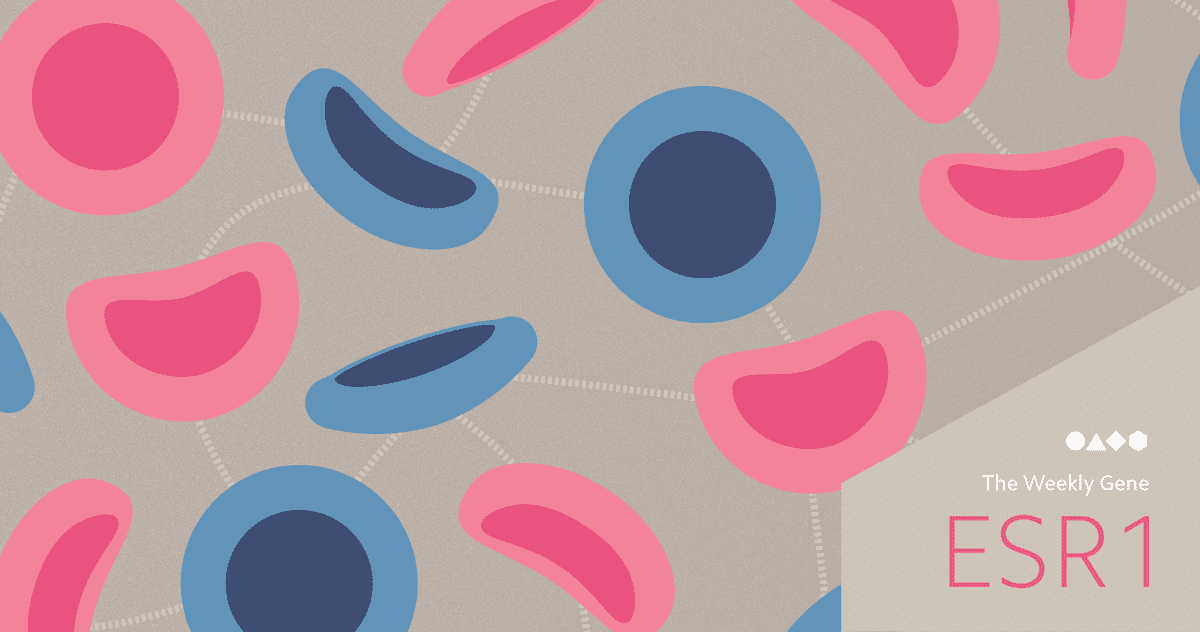Estrogen can change which genes our bodies use

If there was a Hormone Hall of Fame, testosterone and estrogen would definitely be in it. You’ve almost certainly heard of these biomolecules that alter our moods and influence our physiology. But what you may not know is that estrogen is produced in both male and female organs! In fact, estrogen has an important role to play in human physiology that goes well beyond sex determination—it affects our brain, bones, adipose tissue and more. One of estrogen’s most critical partners in making all of this happen is the Estrogen Receptor 1 gene (ESR1).
A hormone is a chemical messenger that travels through the bloodstream (or sap in plants) to evoke a response in other parts of the body1. Exactly what that response is depends on the hormone and how a cell detects it. In the case of estrogen, cells throughout the body make use of estrogen receptor genes2. One of the most well studied of these is the the ESR1 gene, which produces the Estrogen Receptor alpha protein (ERα).
Cholesterol and estrogen?
Estrogen is a term describing multiple molecules, the most prominent being estradiol2. This chemical, along with various other hormones (like testosterone) are synthesized in your body from an unlikely starting source: cholesterol.
Cholesterols, and molecules made from them, have chemical properties similar to the lipids in your cell membranes. This allows them to pass freely between the inside of a cell and the outside. Because estrogen is formed from cholesterol, it’s able to diffuse right past cell membranes. Estrogen can actually meet ERα inside the cell, near the nucleus.
As its name suggests, ERα is a receptor protein, which means that it can detect signals from outside of a cell—in this case, estrogen. Together, ERα and estrogen travel into a cell’s nucleus where they interact with DNA to control whether specific genes can be used or not. It’s easy to read that sentence quickly and miss the significance, but that’s a hugely important feature. That means that cells expressing (producing) the ERα protein can detect estrogen in the blood and may have their gene expression altered because of it2,3.
We have more than 20,000 genes in our DNA, but not every gene is used by each cell. Instead, specific combinations of genes are used by each cell type. A skin cell only uses the genes it needs, which may be different from cells in your bones. The set of genes that are used by a cell determines how the cell behaves and gives it its identity. The fact that estrogen can alter what genes are used in a cell means that it is able to help dictate the way some cells behave and even what those cells become. But in order to do this, estrogen requires proteins like ERα.
ERα can be found in numerous tissues throughout the body including the reproductive organs2. In males, ERα and estrogen appear to have an important role to play in the formation of sperm and in regulation of libido4. In females, ERα and estrogen have a clear role to play in formation of the ovaries, uterus, and mammary glands5. It is believed that, among other actions, the ERα-estrogen complex causes mammary cells to duplicate themselves—an important process for building organs2,3. Outside of the reproductive organs, the ESR1 gene contributes to bone formation, liver function, and adipose tissue (fat) function in both males and females2-7. In each of these locations, estrogen can influence organ development and cell function with the help of the ESR1 gene.
Hormones have a vital role to play in human physiology. But it’s not just hormones that matter—it’s also the proteins and genes that allow us to detect them. Genes like ESR1 give our cells the ability to sense environmental signals and directly respond to them. So no matter who you are, the ESR1 gene is an important facet of your being.
Helix is a personal genomics company that can empower you to improve your life through DNA. Ready to get started? Click here.
1Tata, Jamshed R. “One Hundred Years of Hormones.” EMBO Reports 6.6 (2005): 490–496. PMC. Web. 10 Apr. 2018.
2Cui, Jie, Yong Shen, and Rena Li. “Estrogen Synthesis and Signaling Pathways during Ageing: From Periphery to Brain.” Trends in molecular medicine 19.3 (2013): 197–209. PMC. Web. 10 Apr. 2018.
3Deroo, Bonnie J., and Kenneth S. Korach. “Estrogen Receptors and Human Disease.” The Journal of Clinical Investigation 116.3 (2006): 561–570. PMC. Web. 10 Apr. 2018.
4Schulster, Michael, Aaron M Bernie, and Ranjith Ramasamy. “The Role of Estradiol in Male Reproductive Function.” Asian Journal of Andrology 18.3 (2016): 435–440. PMC. Web. 10 Apr. 2018.
5Findlay, J.K. et al. “Estrogen Signaling in the Regulation of Female Reproductive Functions.” Handbook of experimental pharmacology 198 (2010): 29–35. PMC. Web. 10 Apr. 2018.
6Riggs, B. Lawrence. “The Mechanisms of Estrogen Regulation of Bone Resorption.” Journal of Clinical Investigation 106.10 (2000): 1203–1204. Print.
7Blüher, Matthias. “Importance of Estrogen Receptors in Adipose Tissue Function.” Molecular Metabolism 2.3 (2013): 130–132. PMC. Web. 10 Apr. 2018.